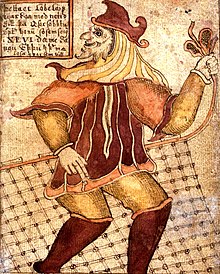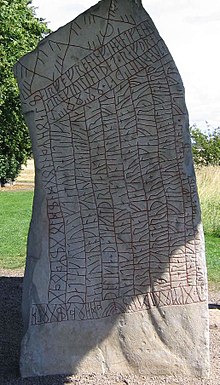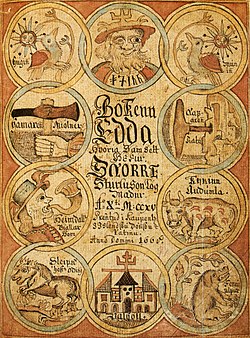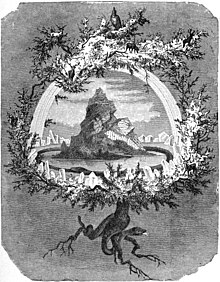Norse mythology

| Mythology |
|---|
Norse, Nordic, or Scandinavian mythology, is the body of myths belonging to the North Germanic peoples, stemming from Old Norse religion and continuing after the Christianization of Scandinavia, and into the Nordic folklore of the modern period. The northernmost extension of Germanic mythology and stemming from Proto-Germanic folklore, Norse mythology consists of tales of various deities, beings, and heroes derived from numerous sources from both before and after the pagan period, including medieval manuscripts, archaeological representations, and folk tradition. The source texts mention numerous gods such as the thunder-god Thor, the raven-flanked god Odin, the goddess Freyja, and numerous other deities.

Most of the surviving mythology centers on the plights of the gods and their interaction with several other beings, such as humanity and the jötnar, beings who may be friends, lovers, foes, or family members of the gods. The cosmos in Norse mythology consists of Nine Worlds that flank a central sacred tree, Yggdrasil. Units of time and elements of the cosmology are personified as deities or beings. Various forms of a creation myth are recounted, where the world is created from the flesh of the primordial being Ymir, and the first two humans are Ask and Embla. These worlds are foretold to be reborn after the events of Ragnarök when an immense battle occurs between the gods and their enemies, and the world is enveloped in flames, only to be reborn anew. There the surviving gods will meet, and the land will be fertile and green, and two humans will repopulate the world.
Norse mythology has been the subject of scholarly discourse since the 17th century when key texts attracted the attention of the intellectual circles of Europe. By way of comparative mythology and historical linguistics, scholars have identified elements of Germanic mythology reaching as far back as Proto-Indo-European mythology. During the modern period, the Romanticist Viking revival re-awoke an interest in the subject matter, and references to Norse mythology may now be found throughout modern popular culture. The myths have further been revived in a religious context among adherents of Germanic Neopaganism.
Terminology
[edit]The historical religion of the Norse people is commonly referred to as Norse mythology. Other terms are Scandinavian mythology,[1][2][3] North Germanic mythology[4] or Nordic mythology.[5]
Sources
[edit]
Norse mythology is primarily attested in dialects of Old Norse, a North Germanic language spoken by the Scandinavian people during the European Middle Ages and the ancestor of modern Scandinavian languages. The majority of these Old Norse texts were created in Iceland, where the oral tradition stemming from the pre-Christian inhabitants of the island was collected and recorded in manuscripts. This occurred primarily in the 13th century. These texts include the Prose Edda, composed in the 13th century by the Icelandic scholar, lawspeaker, and historian Snorri Sturluson, and the Poetic Edda, a collection of poems from earlier traditional material anonymously compiled in the 13th century.[6]
The Prose Edda was composed as a prose manual for producing skaldic poetry—traditional Old Norse poetry composed by skalds. Originally composed and transmitted orally, skaldic poetry utilizes alliterative verse, kennings, and several metrical forms. The Prose Edda presents numerous examples of works by various skalds from before and after the Christianization process and also frequently refers back to the poems found in the Poetic Edda. The Poetic Edda consists almost entirely of poems, with some prose narrative added, and this poetry—Eddic poetry—utilizes fewer kennings. In comparison to skaldic poetry, Eddic poetry is relatively unadorned.[6]

The Prose Edda features layers of euhemerization, a process in which deities and supernatural beings are presented as having been either actual, magic-wielding human beings who have been deified in time or beings demonized by way of Christian mythology.[7] Texts such as Heimskringla, composed in the 13th century by Snorri and Gesta Danorum, composed in Latin by Saxo Grammaticus in Denmark in the 12th century, are the results of heavy amounts of euhemerization.[8]
Numerous additional texts, such as the sagas, provide further information. The saga corpus consists of thousands of tales recorded in Old Norse ranging from Icelandic family histories (Sagas of Icelanders) to Migration period tales mentioning historic figures such as Attila the Hun (legendary sagas). Objects and monuments such as the Rök runestone and the Kvinneby amulet feature runic inscriptions—texts written in the runic alphabet, the indigenous alphabet of the Germanic peoples—that mention figures and events from Norse mythology.[9]
Objects from the archaeological record may also be interpreted as depictions of subjects from Norse mythology, such as amulets of the god Thor's hammer Mjölnir found among pagan burials and small silver female figures interpreted as valkyries or dísir, beings associated with war, fate or ancestor cults.[10] By way of historical linguistics and comparative mythology, comparisons to other attested branches of Germanic mythology (such as the Old High German Merseburg Incantations) may also lend insight.[11] Wider comparisons to the mythology of other Indo-European peoples by scholars has resulted in the potential reconstruction of far earlier myths.[12][13]
Only a tiny amount of poems and tales survive of the many mythical tales and poems that are presumed to have existed during the Middle Ages, Viking Age, Migration Period, and before.[14] Later sources reaching into the modern period, such as a medieval charm recorded as used by the Norwegian woman Ragnhild Tregagås—convicted of witchcraft in Norway in the 14th century—and spells found in the 17th century Icelandic Galdrabók grimoire also sometimes make references to Norse mythology.[15] Other traces, such as place names bearing the names of gods may provide further information about deities, such as a potential association between deities based on the placement of locations bearing their names, their local popularity, and associations with geological features.[16]
Mythology
[edit]Gods and other beings
[edit]
Central to accounts of Norse mythology are the plights of the gods and their interaction with various other beings, such as with the jötnar, who may be friends, lovers, foes, or family members of the gods. Numerous gods are mentioned in the source texts. As evidenced by records of personal names and place names, the most popular god among the Scandinavians during the Viking Age was Thor the thunder god, who is portrayed as unrelentingly pursuing his foes, his mountain-crushing, thunderous hammer Mjölnir in hand. In the mythology, Thor lays waste to numerous jötnar who are foes to the gods or humanity, and is wed to the beautiful, golden-haired goddess Sif.[17]
The god Odin is also frequently mentioned in surviving texts. One-eyed, wolf- and raven-flanked, with a spear in hand, Odin pursues knowledge throughout the nine realms. In an act of self-sacrifice, Odin is described as having hanged himself upside-down for nine days and nights on the cosmological tree Yggdrasil to gain knowledge of the runic alphabet, which he passed on to humanity, and is associated closely with death, wisdom, and poetry. Odin is portrayed as the ruler of Asgard, and leader of the Aesir. Odin's wife is the powerful goddess Frigg who can see the future but tells no one, and together they have a beloved son, Baldr. After a series of dreams had by Baldr of his impending death, his death is engineered by Loki, and Baldr thereafter resides in Hel, a realm ruled over by an entity of the same name.[18]
Odin must share half of his share of the dead with a powerful goddess, Freyja. She is beautiful, sensual, wears a feathered cloak, and practices seiðr. She rides to battle to choose among the slain and brings her chosen to her afterlife field Fólkvangr. Freyja weeps for her missing husband Óðr and seeks after him in faraway lands.[19] Freyja's brother, the god Freyr, is also frequently mentioned in surviving texts, and in his association with the weather, royalty, human sexuality, and agriculture brings peace and pleasure to humanity. Deeply lovesick after catching sight of the beautiful jötunn Gerðr, Freyr seeks and wins her love, yet at the price of his future doom.[20] Their father is the powerful god Njörðr. Njörðr is strongly associated with ships and seafaring, and so also wealth and prosperity. Freyja and Freyr's mother is Njörðr's unnamed sister (her name is unprovided in the source material). However, there is more information about his pairing with the skiing and hunting goddess Skaði. Their relationship is ill-fated, as Skaði cannot stand to be away from her beloved mountains, nor Njörðr from the seashore.[21] Together, Freyja, Freyr, and Njörðr form a portion of gods known as the Vanir. While the Aesir and the Vanir retain distinct identification, they came together as the result of the Aesir–Vanir War.[22]
While they receive less mention, numerous other gods and goddesses appear in the source material. (For a list of these deities, see List of Germanic deities.) Some of the gods heard less of include the apple-bearing goddess Iðunn and her husband, the skaldic god Bragi; the gold-toothed god Heimdallr, born of nine mothers; the ancient god Týr, who lost his right hand while binding the great wolf Fenrir; and the goddess Gefjon, who formed modern-day Zealand, Denmark.[23]
Various beings outside of the gods are mentioned. Elves and dwarfs are commonly mentioned and appear to be connected, but their attributes are vague and the relation between the two is ambiguous. Elves are described as radiant and beautiful, whereas dwarfs often act as earthen smiths.[24] A group of beings variously described as jötnar, thursar, and trolls (in English these are all often glossed as "giants") frequently appear. These beings may either aid, deter, or take their place among the gods.[25] The Norns, dísir, and aforementioned valkyries also receive frequent mention. While their functions and roles may overlap and differ, all are collective female beings associated with fate.[26]
Cosmology
[edit]

In Norse cosmology, all beings live in Nine Worlds that center around the cosmological tree Yggdrasil. The gods inhabit the heavenly realm of Asgard whereas humanity inhabits Midgard, a region in the center of the cosmos. Outside of the gods, humanity, and the jötnar, these Nine Worlds are inhabited by beings, such as elves and dwarfs. Travel between the worlds is frequently recounted in the myths, where the gods and other beings may interact directly with humanity. Numerous creatures live on Yggdrasil, such as the insulting messenger squirrel Ratatoskr and the perching hawk Veðrfölnir. The tree itself has three major roots, and at the base of one of these roots live the Norns, female entities associated with fate.[27] Elements of the cosmos are personified, such as the Sun (Sól, a goddess), the Moon (Máni, a god), and Earth (Jörð, a goddess), as well as units of time, such as day (Dagr, a god) and night (Nótt, a jötunn).[28]
The afterlife is a complex matter in Norse mythology. The dead may go to the murky realm of Hel—a realm ruled over by a female being of the same name, may be ferried away by valkyries to Odin's martial hall Valhalla, or may be chosen by the goddess Freyja to dwell in her field Fólkvangr.[29] The goddess Rán may claim those that die at sea, and the goddess Gefjon is said to be attended by virgins upon their death.[30] Texts also make reference to reincarnation.[31] Time itself is presented between cyclic and linear, and some scholars have argued that cyclic time was the original format for the mythology.[32] Various forms of a cosmological creation story are provided in Icelandic sources, and references to a future destruction and rebirth of the world—Ragnarok—are frequently mentioned in some texts.[33]
Humanity
[edit]According to the Prose Edda and the Poetic Edda poem, Völuspá, the first human couple consisted of Ask and Embla; driftwood found by a trio of gods and imbued with life in the form of three gifts. After the cataclysm of Ragnarok, this process is mirrored in the survival of two humans from a wood; Líf and Lífþrasir. From these two humankind is foretold to repopulate the new and green earth.[34]
See also
[edit]- Alliterative verse
- Family tree of the Norse gods
- List of Germanic deities
- List of valkyrie names in Norse mythology
- Greek mythology
- Roman mythology
- The horse in Nordic mythology
References
[edit]- ^ Rooth, Anna Birgitta (1961). Loki in Scandinavian Mythology. C. W. K. Gleerup. Archived from the original on 19 April 2023. Retrieved 7 September 2018.
- ^ Lindow, John (1997). Murder and vengeance among the gods: Baldr in Scandinavian mythology, Edition 262. Suomalainen tiedeakatemia. ISBN 9514108094. Archived from the original on 19 April 2023. Retrieved 3 October 2020.
- ^ Lindow, John (1988). Scandinavian Mythology: An Annotated Bibliography. Garland Pub. ISBN 0824091736. Archived from the original on 19 April 2023. Retrieved 7 September 2018.
- ^ Murdoch, Brian; Hardin, James N.; Read, Malcolm Kevin (2004). Early Germanic Literature and Culture. Boydell & Brewer. pp. 98–99. ISBN 157113199X.
Of even more importance is Snorri Sturluson, the Icelandic scholar and politician, who did our knowledge of heathen religion such good service... he offers a scholarly portrayal of Old Norse mythology, which is admittedly heavily influenced by his Christian education and classical education, but remains nonetheless our most important medieval source for North Germanic mythology.
- ^ Colum, Padraic (2012). Nordic Gods and Heroes. Courier Corporation. ISBN 9780486119359. Archived from the original on 19 April 2023. Retrieved 7 September 2018.
- ^ a b Faulkes (1995), pp. vi–xxi, and Turville-Petre (1964), pp. 1–34.
- ^ Faulkes (1995), pp. xvi–xviii.
- ^ Turville-Petre (1964), pp. 27–34.
- ^ Lindow (2001), pp. 11–12, Turville-Petre (1964), pp. 17–21, and MacLeod & Mees (2006), pp. 27–28, 216.
- ^ Regarding the dísir, valkyries, and figurines (with images), see Lindow (2001), pp. 95–97. For hammers, see Simek (2007), pp. 218–19, and Lindow (2001), pp. 288–89.
- ^ Lindow (2001), pp. 29–30, 227–28, and Simek (2007), pp. 84, 278.
- ^ Puhvel (1989), pp. 189–221
- ^ Mallory (2005), pp. 128–42
- ^ Turville-Petre (1964), p. 13.
- ^ Regarding Ragnhild Tregagås, see MacLeod & Mees (2006), p. 37. For Galdrabók, see Flowers (1989), p. 29.
- ^ Turville-Petre (1964), pp. 2–3, 178.
- ^ Lindow (2001), pp. 287–91.
- ^ Lindow (2001), pp. 128–29, 247–52.
- ^ Lindow (2001), pp. 118, 126–28.
- ^ Lindow (2001), pp. 121–22.
- ^ Lindow (2001), pp. 241–43.
- ^ Lindow (2001), pp. 311–12.
- ^ Lindow (2001), pp. 86–88, 135–37, 168–72, 198–99, 297–99.
- ^ Lindow (2001), pp. 99–102, 109–10, and Simek (2007), pp. 67–69, 73–74.
- ^ Simek (2007), pp. 108–09, 180, 333, 335.
- ^ Lindow (2001), pp. 95–97, 243–46. Simek (2007), pp. 62–62, 236–37, 349.
- ^ Lindow (2001), pp. 319–32. Simek (2007), pp. 375–76.
- ^ Lindow (2001), pp. 91–92, 205–06, 222–23, 278–80.
- ^ For Hel, see Lindow (2001), p. 172, and Orchard (1997), p. 79. For Valhalla, see Lindow (2001), pp. 308–09, and Orchard (1997), pp. 171–72. For Fólkvangr, see Lindow (2001), p. 118, and Orchard (1997), p. 45.
- ^ For Rán, see Lindow (2001), pp. 258–59, and Orchard (1997), p. 129. For Gefjon, see Orchard (1997), p. 52.
- ^ Orchard (1997), p. 131.
- ^ Lindow (2001), pp. 42–43.
- ^ Lindow (2001), pp. 1–2, 40, 254–58.
- ^ Simek (2007), p. 189.
General sources
[edit]- Edda: Snorri Sturluson. Translated by Faulkes, Anthony. Everyman. 1995. ISBN 0-460-87616-3.
- Flowers, Stephen (1989). The Galdrabók: An Icelandic Grimoire. S. Weiser. ISBN 0-87728-685-X.
- Lindow, John (2001). Norse Mythology: A Guide to the Gods, Heroes, Rituals, and Beliefs. Oxford University Press. ISBN 0-19-515382-0.
- MacLeod, Mindy; Mees, Bernard (2006). Runic Amulets and Magic Objects. Boydell Press. ISBN 1-84383-205-4. Archived from the original on 19 April 2023. Retrieved 17 October 2015.
- Mallory, J. P. (2005). In Search of the Indo-Europeans: Language, Archaeology and Myth. Thames & Hudson. ISBN 0-500-27616-1.
- Orchard, Andy (1997). Dictionary of Norse Myth and Legend. Cassell. ISBN 0-304-34520-2.
- Puhvel, Jaan (1989). Comparative Mythology. Johns Hopkins University Press. ISBN 0-8018-3938-6.
- Turville-Petre, E. O. G. (1964). Myth and Religion of the North: The Religion of Ancient Scandinavia. Holt, Rinehart and Winston.
- Simek, Rudolf (2007). Dictionary of Northern Mythology. Translated by Hall, Angela. D.S. Brewer. ISBN 978-0-85991-513-7.
Further reading
[edit]General secondary works
[edit]- Abram, Christopher (2011). Myths of the Pagan North: the Gods of the Norsemen. London: Continuum. ISBN 978-1-84725-247-0.
- Aðalsteinsson, Jón Hnefill (1998). A Piece of Horse Liver: Myth, Ritual and Folklore in Old Icelandic Sources (translated by Terry Gunnell & Joan Turville-Petre). Reykjavík: Félagsvísindastofnun. ISBN 9979-54-264-0.
- Andrén, Anders. Jennbert, Kristina. Raudvere, Catharina. (editors) (2006). Old Norse Religion in Long-Term Perspectives: Origins, Changes, and Interactions. Lund: Nordic Academic Press. ISBN 91-89116-81-X.
- Branston, Brian (1980). Gods of the North. London: Thames and Hudson. (Revised from an earlier hardback edition of 1955). ISBN 0-500-27177-1.
- Christiansen, Eric (2002). The Norsemen in the Viking Age. Malden, Mass.: Blackwell. ISBN 1-4051-4964-7.
- Clunies Ross, Margaret (1994). Prolonged Echoes: Old Norse Myths in Medieval Northern Society, vol. 1: The Myths. Odense: Odense Univ. Press. ISBN 87-7838-008-1.
- Davidson, H. R. Ellis (1964). Gods and Myths of Northern Europe. Baltimore: Penguin. New edition 1990 by Penguin Books. ISBN 0-14-013627-4. (Several runestones)
- Davidson, H. R. Ellis (1969). Scandinavian Mythology. London & New York: Hamlyn. ISBN 0-87226-041-0. Reissued 1996 as Viking and Norse Mythology. New York: Barnes and Noble.
- Davidson, H. R. Ellis (1988). Myths and Symbols in Pagan Europe. Syracuse, NY: Syracuse Univ. Press. ISBN 0-8156-2438-7.
- Davidson, H. R. Ellis (1993). The Lost Beliefs of Northern Europe. London & New York: Routledge. ISBN 0-415-04937-7.
- de Vries, Jan. Altgermanische Religionsgeschichte, 2 vols., 2nd. ed., Grundriss der germanischen Philologie, 12–13. Berlin: W. de Gruyter.
- DuBois, Thomas A. (1999). Nordic Religions in the Viking Age. Philadelphia: Univ. Pennsylvania Press. ISBN 0-8122-1714-4.
- Dumézil, Georges (1973). Gods of the Ancient Northmen. Ed. & trans. Einar Haugen. Berkeley: University of California Press. ISBN 0-520-03507-0.
- Grimm, Jacob (1888). Teutonic Mythology, 4 vols. Trans. S. Stallybras. London. Reprinted 2003 by Kessinger. ISBN 0-7661-7742-4, ISBN 0-7661-7743-2, ISBN 0-7661-7744-0, ISBN 0-7661-7745-9. Reprinted 2004 Dover Publications. ISBN 0-486-43615-2 (4 vols.), ISBN 0-486-43546-6, ISBN 0-486-43547-4, ISBN 0-486-43548-2, ISBN 0-486-43549-0.
- Lindow, John (1988). Scandinavian Mythology: An Annotated Bibliography, Garland Folklore Bibliographies, 13. New York: Garland. ISBN 0-8240-9173-6.
- Lindow, John (2001). Norse Mythology: A Guide to the Gods, Heroes, Rituals, and Beliefs. Oxford: Oxford University Press. ISBN 0-19-515382-0. (A dictionary of Norse mythology.)
- Mirachandra (2006). Treasure of Norse Mythology Volume I ISBN 978-3-922800-99-6.
- Motz, Lotte (1996). The King, the Champion and the Sorcerer: A Study in Germanic Myth. Wien: Fassbaender. ISBN 3-900538-57-3.
- O'Donoghue, Heather (2007). From Asgard to Valhalla: the remarkable history of the Norse myths. London: I. B. Tauris. ISBN 1-84511-357-8.
- Orchard, Andy (1997). Cassell's Dictionary of Norse Myth and Legend. London: Cassell. ISBN 0-304-36385-5.
- Page, R. I. (1990). Norse Myths (The Legendary Past). London: British Museum; and Austin: University of Texas Press. ISBN 0-292-75546-5.
- Price, Neil S (2002). The Viking Way: Religion and War in Late Iron Age Scandinavia. Uppsala: Dissertation, Dept. Archaeology & Ancient History. ISBN 91-506-1626-9.
- Simek, Rudolf (1993). Dictionary of Northern Mythology. Trans. Angela Hall. Cambridge: D. S. Brewer. ISBN 0-85991-369-4. New edition 2000, ISBN 0-85991-513-1.
- Simrock, Karl Joseph (1853–1855) Handbuch der deutschen Mythologie.
- Svanberg, Fredrik (2003). Decolonizing the Viking Age. Stockholm: Almqvist & Wiksell. ISBN 9122020063 (v. 1); ISBN 9122020071 (v. 2).
- Turville-Petre, E O Gabriel (1964). Myth and Religion of the North: The Religion of Ancient Scandinavia. London: Weidenfeld & Nicolson. Reprinted 1975, Westport, CN: Greenwood Press. ISBN 0-8371-7420-1.
Romanticism
[edit]- Anderson, Rasmus (1875). Norse Mythology, or, The Religion of Our Forefathers. Chicago: S.C. Griggs.
- Guerber, H. A. (1909). Myths of the Norsemen: From the Eddas and Sagas. London: George G. Harrap. Reprinted 1992, Mineola, NY: Dover. ISBN 0-486-27348-2.
- Keary, A & E (1909), The Heroes of Asgard. New York: Macmillan Company. Reprinted 1982 by Smithmark Pub. ISBN 0-8317-4475-8. Reprinted 1979 by Pan Macmillan ISBN 0-333-07802-0.
- Mable, Hamilton Wright (1901). Norse Stories Retold from the Eddas. Mead and Company. Reprinted 1999, New York: Hippocrene Books. ISBN 0-7818-0770-0.
- Mackenzie, Donald A (1912). Teutonic Myth and Legend. New York: W H Wise & Co. 1934. Reprinted 2003 by University Press of the Pacific. ISBN 1-4102-0740-4.
- Rydberg, Viktor (1889). Teutonic Mythology, trans. Rasmus B. Anderson. London: Swan Sonnenschein & Co. Reprinted 2001, Elibron Classics. ISBN 1-4021-9391-2. Reprinted 2004, Kessinger Publishing Company. ISBN 0-7661-8891-4.
Modern retellings
[edit]- Bradish, Sarah Powers (1900). Old Norse stories. New York: American Book Company / Internet Archive.
- Colum, Padraic (1920). The Children of Odin: The Book of Northern Myths, illustrated by Willy Pogány. New York: Macmillan. Reprinted 2004 by Aladdin, ISBN 0-689-86885-5.
- Crossley-Holland, Kevin (1981). The Norse Myths. New York: Pantheon Books. ISBN 0-394-74846-8. Also released as The Penguin Book of Norse Myths: Gods of the Vikings. Harmondsworth: Penguin. ISBN 0-14-025869-8.
- d'Aulaire, Ingri and Edgar (1967). "d'Aulaire's Book of Norse Myths". New York, New York Review of Books.
- Munch, Peter Andreas (1927). Norse Mythology: Legends of Gods and Heroes, Scandinavian Classics. Trans. Sigurd Bernhard Hustvedt (1963). New York: American–Scandinavian Foundation. ISBN 0-404-04538-3.
- Gaiman, Neil (2017). Norse Mythology. W.W. Norton & Company. ISBN 0-393-60909-X.
- Syran, Nora Louise (2000). Einar's Ragnarok
External links
[edit] Media related to Norse mythology at Wikimedia Commons
Media related to Norse mythology at Wikimedia Commons
